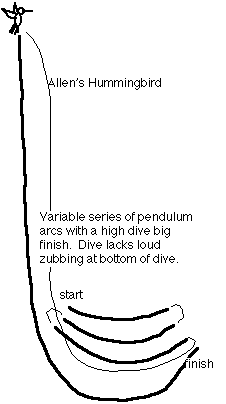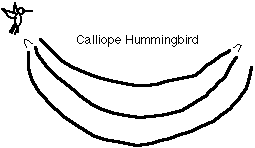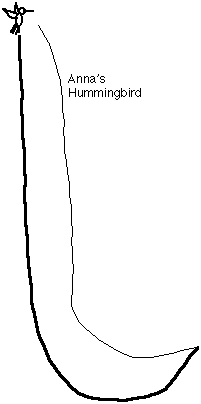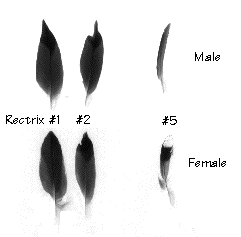Handy Hummer ID Tips
Okay, you've heard from the experts that it's impossible
to separate Selasphorus hummingbirds in the field. Yet, these
same
guys are sending you out to confirm the breeding status of Allen's and
Rufous Hummingbird (technically, Allen's has never been confirmed to
breed
in Oregon beyond displaying males and Rufous has never been confirmed
in
the southern part of its range). What's a poor field observer to do?
Here are some reliable characters that can be used
with
high reliability in the field:
Displays | Plumage
| Gestalt | Other Tips
Displays (click on each image
for
larger display)

|
Allen's Hummingbird is believed to breed on
the Oregon
Coast in Curry County and possibly Southern Coos County. Definitive
evidence
of breeding by this species would be observation of the courtship
display
on multiple days in the same approximate area. The display begins with
a series of shallow pendulum arcs followed by a single rise to perhaps
30m and a steep dive. |

|
Throughout most of Cascadia, the expected Selasphorus
species is Rufous Hummingbird. Its display is described in the Golden
Guide
and in later Peterson's Western Guides as elliptical. This is not
a particularly
good description. Most displays start with an upward rise to about 30m
followed by a rapid downward drop with the bird pulling out near the
ground while making a "zubbing" sound. The bird returns following
the general path of the dive and repeats the procedure.
|
 |
Calliope Hummingbird is a species most
regularly found
in open, high mountain areas. It has a display which is similar to the
front end of the Allen's display. Generally, pendulum arcs are broader
and there is no final dive. Calliopes are also, usually silent. |

|
Anna's Hummingbird is a recent addition to
the avifauna
of the Pacific Northwest first recorded in the late 1940's in Oregon.
It
is the only species which regularly overwinters and is a very early
breeder
(Nov-Dec in California). Nests with eggs have been found in Oregon as
early
as February. The diving display is like the Rufous (or the end of the
Allen's).
It lacks the loud "zubbing" sound that characterizes the arc of the
Rufous,
but often ends its display with a "pop" sound. The Anna's display is
also
typically more 2 dimensional than the Rufous. |
Plumage Characters
One cannot assume that green-backed male
Selasphorus
hummingbirds are Allen's Hummingbirds. Most Rufous Hummingbirds have
some
bits of green and a few have remarkable amounts of green. Here are some
tips based on plumage characters:
1. All red-backed male Selasphorus
hummingbirds
may be assumed to be Rufous Hummingbirds. Any green-backed Selasphorus
hummingbird north or east of its expected range needs to be closely
scrutized
and, where possible, captured for close examination.
2. Male Rufous Hummingbirds have a distinct notch
in tail
feather #2 (the two center most feathers are #1, the next two are #2
and
so on to the outer most #5).
 It is generally believed that this notch produces the
distinctive
"zubbing" sound during displays. Allen's Hummingbird lacks this notch.
It should be theoretically possible to see this notch if the bird is
sufficiently
close. The tail feathers of Rufous Hummingbirds for males and females
are
wider than those of Allen's Hummingbirds. It is probably less reliable,
but may possibly be observed if both species are present for comparison.
It is generally believed that this notch produces the
distinctive
"zubbing" sound during displays. Allen's Hummingbird lacks this notch.
It should be theoretically possible to see this notch if the bird is
sufficiently
close. The tail feathers of Rufous Hummingbirds for males and females
are
wider than those of Allen's Hummingbirds. It is probably less reliable,
but may possibly be observed if both species are present for comparison.
Gestalt
Ooo, Gestalt. You didn't realize that birding was
connected
to Jungian psychology and the collective unconscious, did you? In
birding,
gestalt (or jizz) refers to qualitative, difficult to describe
characters.
Jizz characters are only useful to those who have considerable
experience
with both Selasphorus hummingbirds.
Allen's Hummingbirds are generally described as
"seeming
smaller." They "have a shorter looking tail." Allen's seem "less
aggressive,"
and "quieter." All of these descriptions may, in fact, be true, but the
degree to which they are useful depends to a large extent upon what you
want to believe. If you are pre-disposed to believe you have an Allen's
Hummingbird, it's not all that hard to convince yourself that it has
unusual
characters.
Other tips
Displays | Plumage
| Gestalt | Other Tips
This page created on March 11, 1997